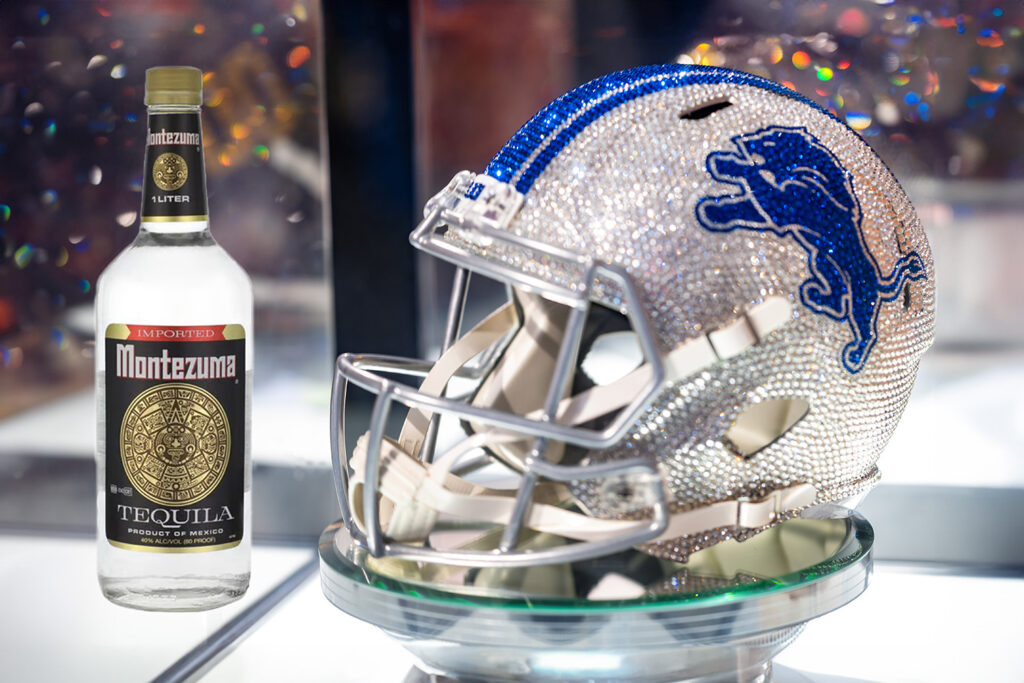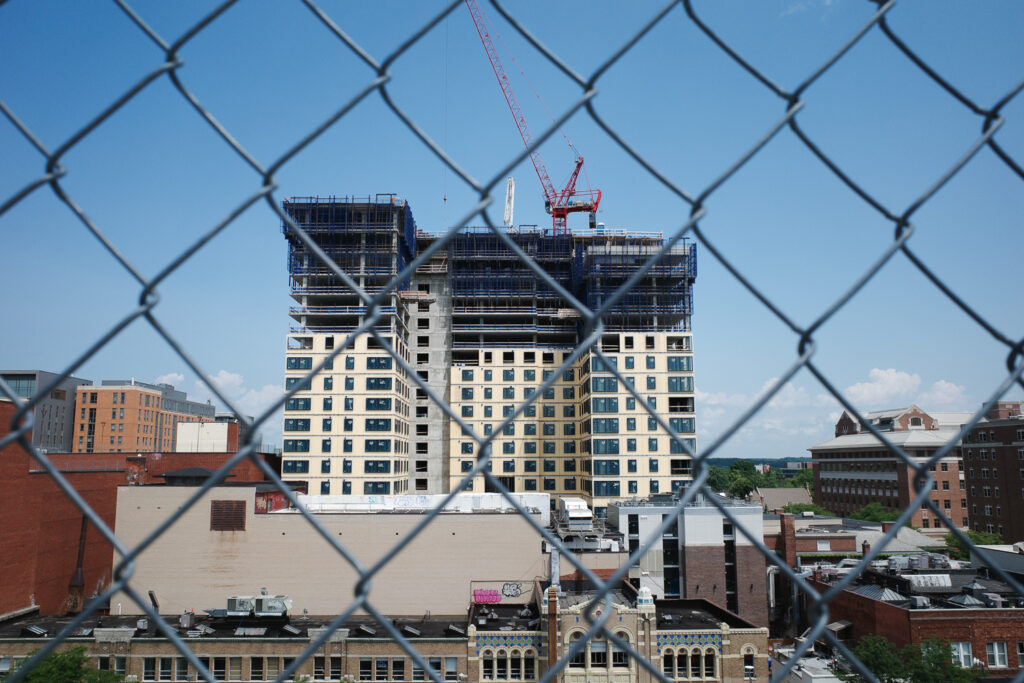The Woodland Center Correctional Facility is a high-security prison that serves specifically as an infirmary for the criminally insane. Across the street, outside its gates and barbed wire, I too have gone crazy—with how much fun I’m having at the Futureball Paintball and Airsoft Park.
It’s Sunday afternoon and there’s a heat wave. Onsite are only sweaty men. They’ve come not only to play but to fight the emptiness. To fulfill an urge deep in their bones. To go to war.
Break time is only 15 minutes between games. It’s a chance to cool down and restock. Everyone is replenishing something, whether filling their mouths with water, their magazines with ammunition, or their lungs with nicotine.
Next to me are two men in their late forties sucking on cigarettes. One of them is shirtless with a scorpion tattoo on his right shoulder. He is proudly sporting a distended abdomen—bloated by consumption rather than privation—in that nymphal stage between pot belly and beer gut. His torso attracts my attention because it’s covered in polka dots. Paintball welts.
He bends forward and sticks his face into the man-made breeze. A fan slurps water from a Home Depot pail. It blows mist into his face. He sighs in relief, then looks at his friend. Then at me. And probably not for the first time today, he blurts out: “I’m too old for this shit.”
We start talking. The two men are celebrating their 25th anniversary of playing paintball together. The first time was for one of their bachelor parties. They soon became obsessed and spent thousands on gear. They started working at Futureball for the discounted rates. But now they come less often, since Father Time has heaped on paternal responsibilities. They groan about sharing childcare with their wives. When here though, they still have a blast.
It’s also getting expensive, almost $200 dollars a day, admits the man with the belly. A night out drinking can cost more. “No. Not for us,” the other man counters. He thinks a little, and qualifies, “Well maybe at the strip club. Yeah, I’ve spent way more money at the strip club. More in 15 minutes there than in 15 hours here.”
Home Economics in a man’s world.
The friend says he once crossed the border for a paintball tournament. It was many years ago, when America still trailed Canada in social progress. “I was with a guy, with long blonde hair, who looked like Jesus. We had finished a competition and wanted to get drunk. I can’t remember where in Canada, but we had to go to Gay Town to find the Beer Store.” Until recently, Ontario only sold alcohol in two approved dispensaries: the LCBO and the Beer Store. “We walked down the main strip, topless, covered in white goo and purple welts, with cases of beer, looking like we had just partied all night with the f****ts!”
He says this completely without malice. He even admits to pilfering a queer periodical. As a joke, he insists. It supposedly helped him cross back into America. He tells me, “Usually when border security sees the paintball guns, they do a thorough check through all our bags. But the gay magazine was on top of my gear, and the officer slammed the gun case shut. They moved us along without questions.”
The frivolity doesn’t last. A referee announces that break time is over. Everyone gets their guns and leaves for the “battleground.”
*
Paintball and airsoft are separate activities, and today I’m only playing the latter.
My rental is a replica based on the M4 platform. Capable of both semi-automatic and automatic fire (aka “the fun switch”). The gun is battery powered and shoots biodegradable plastic BBs at 400 feet per second. I will swap out the battery every three games to ensure my ammo travels at maximum velocity, which, in relatable terms, is about 122 miles per hour. On bare skin, at close range, the BBs sting. They hurt just enough that players prefer not getting hit. The feeling that’s most similar is getting pelted by kamikaze dragonflies while speeding a motorcycle shirtless on country roads.
To avoid eye damage, or welts that would look like pimples, the gun comes with a complimentary face mask. It offers good protection but creates an obstacle. The mask’s chin butts against the rifle’s stock and prevents me from looking through the sights. For the rest of the day, I’ll have to aim by tracing my rounds. Not that airsoft guns are especially accurate. The ammunition is made from perfectly spherical balls, which means they bend and curve unpredictably in a similar way to how a knuckler floats and flutters, erratically, in baseball. Real bullets have rounded or pointed ends which gives them aerodynamic precision.
Before we enter the field, we are given a warning: any real guns on the park property will result in a lifetime ban and the police. A referee jokes, “The woodland prison is across the street, and they respond very quickly.”
While I had been waiting, an employee told me about how the FBI came to these playgrounds as part of the OKBOMB investigation after the Oklahoma City Bombing. Timothy McVeigh would frequently visit his future co-conspirator Terry Nichols in Lapeer, less than an hour away. Futureball Paintball and Airsoft Park had just opened. The FBI were curious if Timothy or Terry had ever trained here, but they never had.
It was a reasonable assumption. The police train here all the time, but it has its shortcomings. Having to get within 200 feet to shoot another man with plastic balls is obviously not the same as pumping a violent crackhead full of lead. Not to mention that, in airsoft, you can hide behind plastic tarps for cover. But the game keeps the mind sharp: angles are the same for aiming around objects; shooting positions are the same; attack and defensive strategies are similar. It’s good supplemental training anyway, in addition to the gun range—because range targets do not shoot back. These conversations often start a very niche debate.
Within every culture, subcultures fight for supremacy. Each claims to be the best while disparaging others for the slightest difference. Over the course of one afternoon, I heard it all. For airsoft players, paintball is not realistic enough. For paintball players, airsoft is feigning realism. For boogaloo survivalists, airsoft and paintball are kid games. For airsoft and paintball enthusiasts, survivalists will stockpile ammo but struggle to run up a flight of stairs. These debates, however foreign to outsiders, are actually a sign of masculine health. Hobbies advance through fanatic devotion and autistic disputation.
A Chinese guy named Dan, with an armory’s worth of kit, explains the infighting. He is soft spoken and displays a Velcro patch that reads, “Eat Ass. Shoot Fast.” Full camouflage, tactical gloves, combat boots. To make things harder in this heat, he saddles himself with a plate carrier and a modular chest rig with extra magazine pouches. He’s also wearing headgear: a metal helmet, noise canceling earmuffs, goggles and a mesh face guard. His rifle once shot paintballs but was converted into an airsoft gun. It uses blowback gas to simulate the recoil of a real gun. He carries a pistol too, with a useless silencer, and he runs with a radio. For night competitions, there’s even more gear. He comes with a barrel-mounted flashlight and laser as well as night-vision goggles mounted to his helmet, which costs anywhere from $2,000 – $10,000. Glow-in-the-dark BBs are used as tracer rounds.
He explains why airsoft is unfairly mocked for fetishizing realism, especially MILSIM—short for military simulation. It’s when adults “play war” with massive budgets. The events can be big: 48 hours long, with hundreds of participants, on thousands of acres.
The most extreme versions include players driving in armored vehicles and flying in helicopters. Real guns shoot blanks, and explosives are detonated to add intensity to the game. Because these events are overnight, people bring camping equipment, make fires, cook food, and use the highest level of technology to coordinate attacks, raid, and plan defensive holds. It’s a huge LARP in the most literal sense, but in this instance the term isn’t insulting. The whole point for MILSIM is to get as close to the real thing as possible. Its enthusiasts make a good point: “All training is a LARP. We just take it more seriously.”
But MILSIM isn’t only about training for the future. For many players, it’s about coping with the past. MILSIM attracts many combat veterans. Especially those who’ve returned home from deployment with PTSD. Civilians have empathy for soldiers wallowing in bloodstained memories. But they often lack some understanding about the other side of PTSD. Which is that coming back to domesticated life can be so boring, so lifeless, that mere existence becomes another kind of trauma—a trauma, not caused by something, but by the lack of something.
A warrior burdens tragedy: friends turned into casualties; near brushes with death; constant betrayal by politicians. But he also experiences foreign adventure, grand narrative, and genuine purpose. What does he return home to? Grocery shopping and the culture war? A political debate consumed by weather patterns, bathroom signs, and gas prices?
It’s too easy to blame our particular self-loathing politics. And it’s not unique to the current year. This is after all the inciting basis of both The Hurt Locker and Apocalypse Now. Also watch Deer Hunter or Rolling Thunder for examples of soldiers who remain agitated in their souls after returning from war.
Veterans struggle to adjust with our mundane concerns. Even their psychology trails behind in the war zones of their past lives. Another man I am playing with overhears my conversation with Dan and tells me what he’s been told by veterans: “All these vets from Afghanistan and Iraq say, ‘My mind is still over there’ and MILSIM scratches the itch.”
It’s not only therapeutic nostalgia. MILSIM gives veterans a chance to show their unique talent—how to kill effectively. It’s what they’ve trained for their entire lives. For many little boys nursed on action movies, it’s our first dream. The ability to commit violence, honorably and effectively, is the ultimate expression of male competence. And imagine being amazing at man’s highest calling, with no one to ever witness it. MILSIM is the closest analog where soldiers can demonstrate their excellence.
*
Sometimes you can respawn. Sometimes you’re dead. In MILSIM, it’s one shot dead. In what I am doing, they change the rules depending on the referee’s whim.
I’m getting destroyed. I’m running from tree to tree, diving behind cover, getting as close as I can, only to get hit as soon as I peek behind a stump. The tactics I’ve used in paintball, which is played faster and more aggressively, are getting me shot early and often. I’m not playing conservatively. I like to run and raid. It’s humbling. I suck.
It’s also sobering. Whenever I watch war movies or read memoirs, I naturally relate to the survivors. It’s easy to imagine oneself as the lucky one—as the guy who survives the loss of his friends. Getting shot in the face with a plastic orb at a speed that’s only a fraction of real bullets is a good remedy for such illusions. So is real combat footage, such as what’s coming out of Eastern Europe, where soldiers die by remote control.
On those real battlefields, there are drones. They fly around slowly, like lethal insects, giving men just enough time to pray for mercy and forgiveness. I saw one video recently in which a soldier looks directly into a drone’s camera and folds his hands. The man is pleading for his life. What’s remarkable is that you can see the very moment the soldier regresses, from man to boy. The operator presses a button; the drone explodes. The boy lies down in a nameless field for now and all eternity.
It’s sad and repulsive.
Such technological advancements remove all dignity from armed conflict. It leaves nothing to skill and everything to chance. I have to remind myself of this tragic reality as I get better at airsoft throughout the day, because otherwise I’ll start to romanticize war.
I’m playing with two Ukrainian boys who’ve recently moved to the U.S. They are here with a Russian friend. The war hasn’t gotten in the way of their friendships. They must be in their early teens. Small and still growing. They shoot at each other and then cuss in their native tongues. On this little plot of Michigan forest, they simulate what their compatriots are doing in wheat fields, but, unlike those soldiers destined for slaughter, these boys get a chance to respawn.
The small boys are better than many of the large men, the boys dropped off by clingy mothers; men escaping their wives. It’s not just the all-male space that makes it interesting. The game is played in perfectly democratic terms. Whereas some sports give advantage to bigger and stronger men, or to kids with cleaner lungs and more athleticism, the gun is the great equalizer. No one is patronizing. Everyone is here to play.
During my last game, I was pinned behind some plywood. We were playing in full-auto, and several players were shooting at me simultaneously. The continuous tap of BBs against the wood sheet sounded like a descent of woodpeckers, if they were all hungry and high on amphetamines. It gave me a chance to look around. Near us, a muskrat was tearing into a squirrel and pulling out its viscera. Above us, a small bird was mobbing a bald eagle. At that moment we—the boys and men—were the only animals playing at killing each other.
Mitch Miller is an adventure writer and conflict journalist. Follow him on X @funtimemitch.




